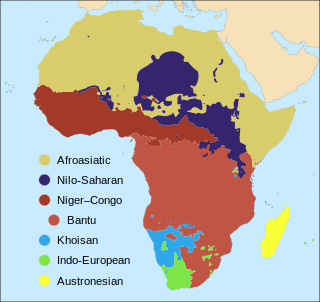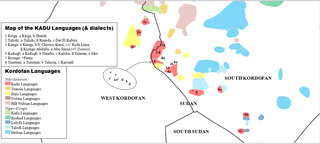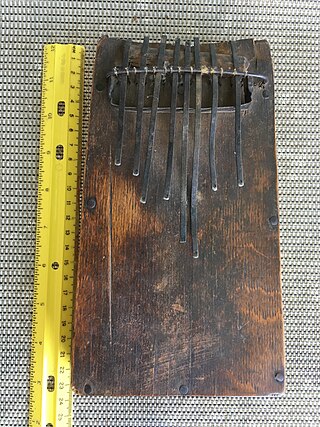
The Afroasiatic languages, also known as Hamito-Semitic or Semito-Hamitic, are a language family of about 400 languages spoken predominantly in West Asia, North Africa, the Horn of Africa, and parts of the Sahara and Sahel. Over 500 million people are native speakers of an Afroasiatic language, constituting the fourth-largest language family after Indo-European, Sino-Tibetan, and Niger–Congo. Most linguists divide the family into six branches: Berber, Chadic, Cushitic, Egyptian, Semitic, and Omotic. The vast majority of Afroasiatic languages are considered indigenous to the African continent, including all those not belonging to the Semitic branch.

The Chadic languages form a branch of the Afroasiatic language family. They are spoken in parts of the Sahel. They include 150 languages spoken across northern Nigeria, southern Niger, southern Chad, the Central African Republic, and northern Cameroon. By far the most widely spoken Chadic language is Hausa, a lingua franca of much of inland Eastern West Africa, particularly Niger and the northern half of Nigeria.

The Cushitic languages are a branch of the Afroasiatic language family. They are spoken primarily in the Horn of Africa, with minorities speaking Cushitic languages to the north in Egypt and Sudan, and to the south in Kenya and Tanzania. As of 2012, the Cushitic languages with over one million speakers were Oromo, Somali, Beja, Afar, Hadiyya, Kambaata, and Sidama.

The Nilo-Saharan languages are a proposed family of African languages spoken by somewhere around 70 million speakers, mainly in the upper parts of the Chari and Nile rivers, including historic Nubia, north of where the two tributaries of the Nile meet. The languages extend through 17 nations in the northern half of Africa: from Algeria to Benin in the west; from Libya to the Democratic Republic of the Congo in the centre; and from Egypt to Tanzania in the east.

The number of languages natively spoken in Africa is variously estimated at between 1,250 and 2,100, and by some counts at over 3,000. Nigeria alone has over 500 languages, one of the greatest concentrations of linguistic diversity in the world. The languages of Africa belong to many distinct language families, among which the largest are:

The Omotic languages are a group of languages spoken in southwestern Ethiopia, in the Omo River region and southeastern Sudan in Blue Nile State. The Geʽez script is used to write some of the Omotic languages, the Latin script for some others. They are fairly agglutinative and have complex tonal systems. The languages have around 7.9 million speakers. The group is generally classified as belonging to the Afroasiatic language family, but this is disputed by some.
Shabo is an endangered language and likely language isolate spoken by about 400 former hunter-gatherers in southwestern Ethiopia, in the eastern part of the South West Ethiopia Peoples' Region.

In most classifications, the Eastern Sudanic languages are a group of nine families of languages that may constitute a branch of the Nilo-Saharan language family. Eastern Sudanic languages are spoken from southern Egypt to northern Tanzania.
Lowland East Cushitic is a group of roughly two dozen diverse languages of the Cushitic branch of the Afro-Asiatic family. Its largest representatives are Oromo and Somali.

The Kadu languages, also known as Kadugli–Krongo or Tumtum, are a small language family of the Kordofanian geographic grouping, once included in Niger–Congo. However, since Thilo Schadeberg (1981), Kadu is widely seen as Nilo-Saharan. Evidence for a Niger-Congo affiliation is rejected, and a Nilo-Saharan relationship is controversial. A conservative classification would treat the Kadu languages as an independent family.
The Surmic languages are a branch of the Eastern Sudanic language family.

The languages of Ethiopia include the official languages of Ethiopia, its national and regional languages, and a large number of minority languages, as well as foreign languages.
Harold Crane Fleming was an American anthropologist and historical linguist specializing in the cultures and languages of the Horn of Africa. As an adherent of the Four Field School of American anthropology, he stressed the integration of physical anthropology, linguistics, archaeology, and cultural anthropology in solving anthropological problems.

The Majang people, or Majangir, live in southwestern Ethiopia and speak a Nilo-Saharan language of the Surmic cluster. The 1998 census gave the total of the Majangir population as 15,341, but since they live scattered in the hills in dispersed settlements, their actual total number is undoubtedly much higher. They live around cities of Tepi, Mett'i, and scattered southwest of Mizan Teferi and towards Gambela.
The Bʼaga languages, also known as Gumuz, form small language family spoken along the border of Ethiopia and Sudan. They have been tentatively classified as closest to the Koman languages within the Nilo-Saharan language family.
The Komuz languages are a proposed branch of the Nilo-Saharan language family which would include the Koman languages, the Gumuz languages and the Shabo language, all spoken in south-eastern Sudan and western Ethiopia. Nilo-Saharan specialists have vacillated on a genealogical relationship between the Koman and Gumuz languages, a relationship called Komuz. Greenberg (1963) had included Gumuz in the Koman language family. Bender classified them together in a distant relationship he called Komuz, but by 1996 he had reversed himself, though he kept both groups in core Nilo-Saharan. Dimmendaal (2008) kept them together, though expressed doubts over whether they belonged in Nilo-Saharan, later referring to Gumuz as an isolate (2011). Ahland, on the basis of new Gumuz data, resurrected the hypothesis. Blench (2010) independently came to the same conclusion and suggested that the Shabo language might be a third, outlying branch. The classification of Shabo is difficult because of a strong Koman influence on the language that is independent of any genealogical relationship between them. Schnoebelen (2009), moreover, sees Shabo as a likely isolate.
The Ethiopian language area is a hypothesized linguistic area that was first proposed by Charles A. Ferguson, who posited a number of phonological and morphosyntactic features that were found widely across Ethiopia and Eritrea, including the Ethio-Semitic, Cushitic and Omotic languages but not the Nilo-Saharan languages.
Maʼa is a Bantu language of Tanzania.

The Proto-Afroasiatic homeland is the hypothetical place where speakers of the Proto-Afroasiatic language lived in a single linguistic community, or complex of communities, before this original language dispersed geographically and divided into separate distinct languages. Afroasiatic languages are today mostly distributed in parts of Africa, and Western Asia.

Azeb Amha (1967) is a linguist working on the morphology and syntax of Afroasiatic languages, with a special focus on Omotic languages. A senior researcher at the African Studies Center Leiden, Azeb is co-editor of the international Journal of African Languages and Linguistics and member of the board of the Dutch Society for African Studies (NVAS).










